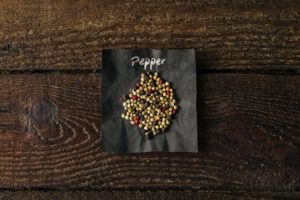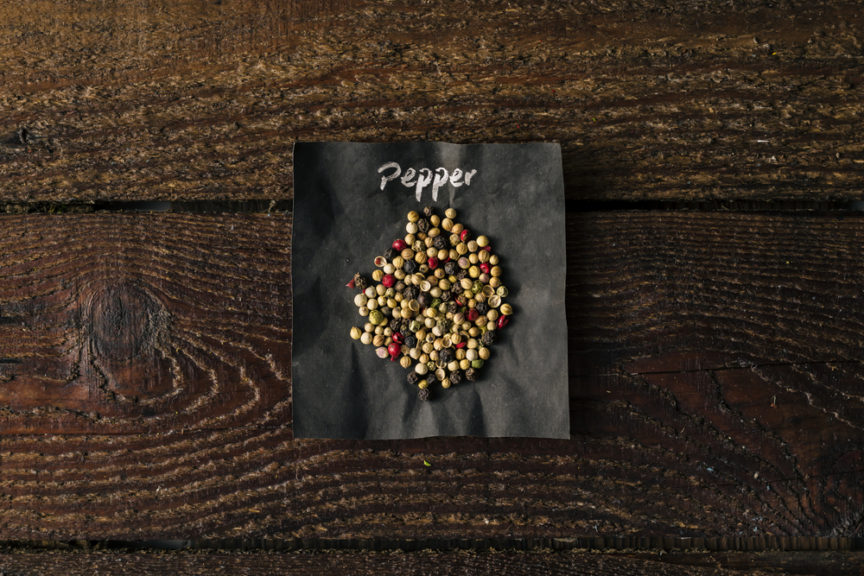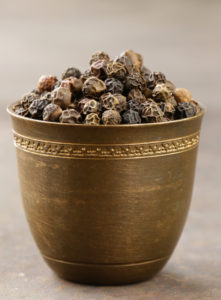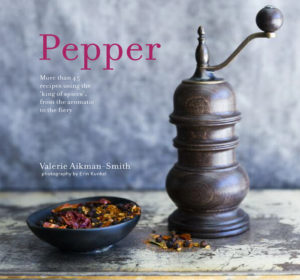Dried ground pepper has been used since antiquity for both its flavour and as medicine and is the world’s most traded spice. It is one of the most common spices added to cuisines around the world. Black pepper is used all over the world as a seasoning and is often paired with salt. Black peppercorns were found stuffed in the nostrils of Ramesses II, placed there as part of the mummification process after his death in 1213 BC.
A flowering vine, black pepper is cultivated for its fruit, which is dried and used as a spice and seasoning. Its dried fruit is a peppercorn. Often called the king of spices, pepper has a long history of being used as a seasoning, a preservative, and even currency. By far the most frequently used of all the spices, pepper adds a depth of flavour to savory dishes, and can perhaps surpisingly be added so some sweet dishes with success.
Valerie Aikman-Smith’s new cookbook, simply called Pepper, makes use of exciting varieties and styles of black peppercorns, including single-estate and gourmet varieties such as Malabar from India, Lampong from Indonesia and Tellicherry from Goa. Chinese szechuan and Japanese sansho also feature in the recipes which are aimed at the home chef. These are diverse and interesting ideas from simple pickles, mustards and infused oils (which can be used to season when cooking, or at the table) to attractive options such as Peppered Fish Ceviche, or Handmade Lemon Pepper Gnocchi to Summer Berry Salad with Peppered Blackberry Syrup.
Once used as currency and presented to the gods as a sacred offering, it is fortunate that this most popular of spices is available throughout the year.
It has given us the word ‘pep’, as in to imbue spirit or energy and according to the World Health Foods website, black pepper stimulates the taste buds while having demonstrated impressive antioxidant and antibacterial effects. Blck pepper helps you derive the most benefit from your food as the outer layer of the peppercorn stimulates the breakdown of fat cells, so it could be helping to keep you slim too.
Black pepper, green pepper and white peppercorns are the same fruit (Piper nigrum); the difference in their colour is due to the stages of development and processing methods. Black peppercorns are made by picking the pepper berries when they are half ripe and about to turn red. They are left to dry which causes them to shrivel and become dark in colour. Green peppercorns are picked while still unrip, while white peppercorns are picked when very ripe and subsequently soaked in brine to remove their dark outer shell leaving just the white pepper seed. Only pink peppercorns are from a completely different plant species (Schinus molle).
 Whole peppercorns will keep almost indefinitely, while ground pepper will stay fresh for about three months. If you freeze pepper it will make its flavor more pronounced. It’s best to add pepper that you have freshly ground in a mill at the end of the cooking process as it loses its flavour and aroma if cooked for too long.
Whole peppercorns will keep almost indefinitely, while ground pepper will stay fresh for about three months. If you freeze pepper it will make its flavor more pronounced. It’s best to add pepper that you have freshly ground in a mill at the end of the cooking process as it loses its flavour and aroma if cooked for too long.
Black pepper per 100g: 251 calories, 3.3g fat, a fair hit of potassium, and quite carb-y at 64g per 100g of pepper. It’s also got a dash of magnesium, calcium and iron. But in all fairness in the amounts usually used, you’re not going to absorb any fat or carbs worth worrying about. One tablespoon (or two teaspoons) is about a 6g, whereas all you are likely to need for normal family cooking is a good grind or two which won’t be much at all.
Food features and recipes like this appear in the Desang Diabetes Magazine, our free-to-receive digital journal. We cover diabetes news, diabetes ‘kit’ and information on food suitable for maintaining good blood glucose control or a diabetic diet, including a regular Making Carbs Count column. It’s free! Go to the top of this page to sign up – we just need your email address. See current and past issues at
www.desang-magazine.co.uk
Open publication



